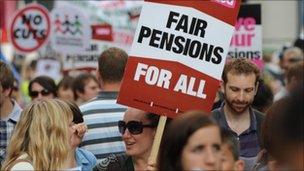Pensions reform: Lessons from the storm
- Published

Plans to change public sector pensions have prompted widespread protests
Warnings about the future of pensions have come thick and fast in recent weeks.
Protests and union anger about plans to make public servants pay more into their pension schemes may have been given the biggest coverage.
But those with - or without - a private sector workplace pension have also been faced with reports suggesting a dark financial future.
So, what are the key messages that have emerged, how much attention should be paid to them, and how much worse off are people likely to be, depending on where they work?
Here, we examine the key issues, illustrated with some of the most striking comment.
'I certainly do not think it is a reason for anyone to go on strike'
Chancellor George Osborne's views on plans to raise pension contributions from public sector employees were not shared by many of the unions.
A total of 2.5 million NHS workers and teachers in England and Wales, and civil servants in England, Scotland and Wales were told they will have to pay £1.1bn in extra contributions from April 2012.
Proposed increases in pension contributions |
||||||||
|---|---|---|---|---|---|---|---|---|
| NHS | Teachers | Civil servants | ||||||
| Annual salary | Now | From 2012 | Annual salary | Now | From 2012 | Annual salary | Now* | From 2012* |
| Average pension £7,000 | Average pension £10,000 | Average pension £6,200 | ||||||
|
Source: Cabinet Office, Department of Health, Department for Education |
||||||||
|
*Lower figure is for classic pension scheme and the higher figure for other schemes |
||||||||
|
Up to £15,000 |
5.00% |
5.00% |
Up to £14,999 |
6.4% |
6.4% |
Up to £15,000 |
1.5% - 3.5% |
1.5% - 3.5% |
|
£15,001 - £21,175 |
5.00% |
5.60% |
£15,000 - £25,999 |
6.4% |
7.0% |
£15,001 - £21,000 |
1.5% - 3.5% |
2.1% - 4.1% |
|
£21,176 - £26,557 |
6.50% |
7.14% |
£26,000 - £31,999 |
6.4% |
7.3% |
£21,001 - £30,000 |
1.5% - 3.5% |
2.7% - 4.7% |
|
£26,558 - £48,982 |
6.50% |
7.69% |
£32,000 - £39,999 |
6.4% |
7.6% |
£30,001 - £50,000 |
1.5% - 3.5% |
3.1% - 5.1% |
|
£48,983 - £69,931 |
6.50% |
8.48% |
£40,000 - £74,999 |
6.4% |
8.0% |
£50,001 - £60,000 |
1.5% - 3.5% |
3.5% - 5.5% |
|
£69,932 - £110,273 |
7.50% |
9.85% |
£75,000 - £111,999 |
6.4% |
8.4% |
Over £60,000 |
1.5% - 3.5% |
3.9% - 5.9% |
|
Over £110,273 |
8.50% |
10.90% |
Over £112,000 |
6.4% |
8.8% |
|||
These figures had been discussed previously. In fact, many of these workers are now being asked to make smaller increases to their contributions than they might have originally expected.
However, it still means that a teacher on £35,000 a year, who currently pays 6.4% of their salary into their pension, will have to pay in 7.6% of their salary from April - with more potential rises to come.
So how does that compare with the private sector?
Average employee contributions by those in a defined benefit scheme - such as a final-salary scheme - were 4.9% in 2008, according to the latest statistics in the Pension Trends compendium by the Office for National Statistics (ONS).
For those in defined contribution schemes - when the final sum depends on the success of investments - it was 3%.
Estimates suggest that private sector workers and their employers would have to pay anything between 15% and 40% of their pay into a defined contribution plan to receive the same benefits as a public sector worker in a final-salary scheme.
However, in his report to the government about the future of public sector pensions, Lord Hutton said public sector reform should not be a race to the bottom to match what was happening in the private sector.
'We simply are not saving enough to secure a decent retirement'
There may be huge debate over the level of contributions being demanded from workers, but 14 million people are not paying into a workplace pension at all, according to a report from the Workplace Retirement Income Commission.

Many pensioners are facing a "bleak old age", one report suggested
There is a marked difference in workplace pension scheme membership between the public and private sectors.
In 1997, 52% of male employees and 37% of female employees belonged to a pension scheme in the private sector, according to the ONS. But by 2010, this had fallen to 39% of male employees and 28% of female employees.
Over the same period, the proportion of male employees in the public sector belonging to a pension scheme remained unchanged at 87%, while for women, it went up from 75% to 82%.
The lowest earners are least likely to be members.
The Commission's report concluded that others - failing to save enough - are facing a "bleak old age".
It blamed the "complex, costly and inefficient" pension system, opaque charges, and a spending culture, among other issues, for the likelihood that millions of people could end up relying on little more than the state pension.
Given all the changes to pensions recently, it is likely that everyone - in public sector and in private sector schemes - is likely to be worse off in terms of pension income than they were expecting.
But, given the multitude of schemes around, and ongoing changes to these schemes, it is very difficult to pinpoint who will be worst off in the long-run.
The government will start to automatically enrol workers into pension schemes soon, but the report echoed many commentators in questioning whether this would be enough.
'We are seeing a small-print lottery'
One change to the way pensions are calculated will save the government billions of pounds, but will be less generous to those with public sector or state pensions.
In its Budget in June 2010, the government said it was to change the index for inflation-proofing in the pension schemes from the Retail Prices Index (RPI) to slower-growing Consumer Prices Index (CPI).
The CPI generally rises each year by about 0.7 percentage points less than the RPI.
That would mean after a typical retirement of 25 years, £1,000 of pension could grow to £2,480 with RPI and only £2,094 with CPI, according to actuaries Aon Hewitt.
This has prompted some private sector companies to make the same switch, saving UK employers £73bn, according to LCP.
But the firm of actuaries pointed out that while some companies can make the change, the rules in the pensions schemes of others prevent them from doing so.
"The change to CPI is entirely dependent on the wording of each scheme's rules and we are seeing a small print lottery under which a 45-year-old deferred pensioner in one scheme is unaffected yet a similar member in another scheme could stand to lose roughly a quarter of the value of their pension," said senior partner Bob Scott.
'People may be using savings to pay higher household bills'
By 2066 it is estimated there will be at least half-a-million people aged over 100, according to the latest figures from the Department for Work and Pensions.
Today's 20-year-olds are three times more likely to live to 100 than their grandparents and twice as likely as their parents.
So they are being urged to consider getting into the savings habit early in their lives.
But the latest statistics from the British Bankers' Association (BBA) suggested that this was being curtailed by the squeeze on household finances.
"Personal deposits are growing only slowly as some people may be using savings to pay higher household bills," said David Dooks, the BBA's statistics director.